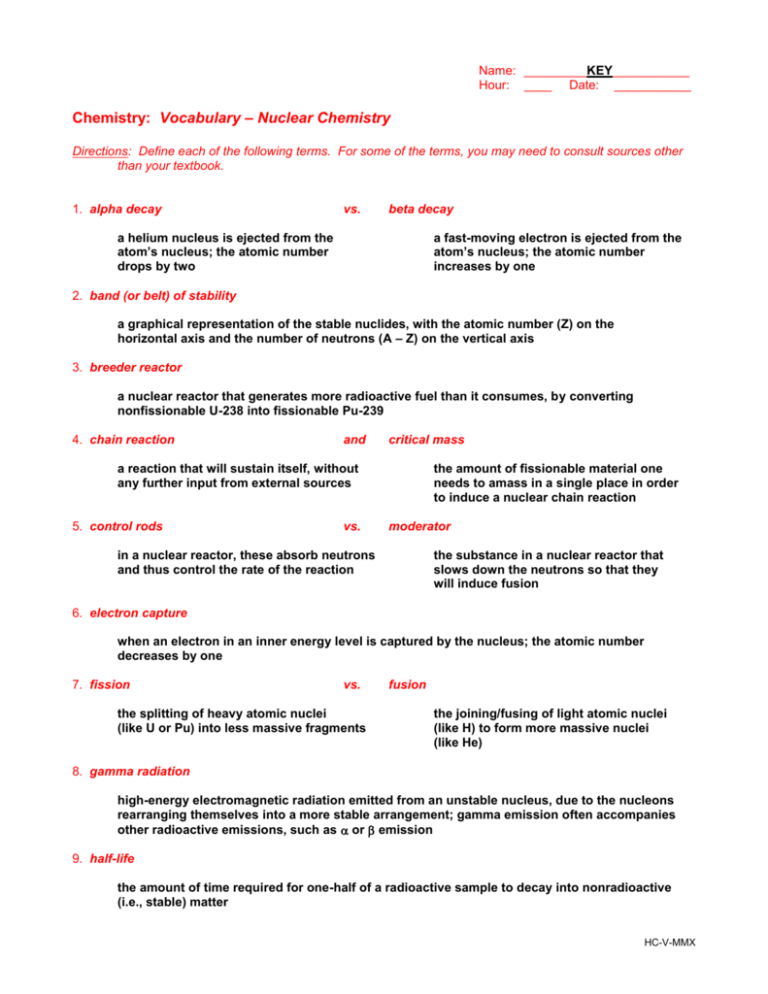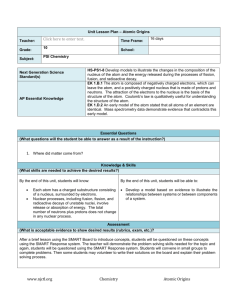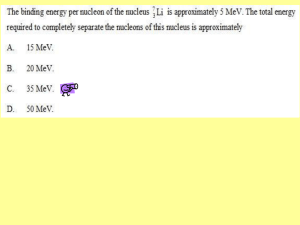Chemistry: Soap Article
advertisement

Name: _________KEY___________ Hour: ____ Date: ___________ Chemistry: Vocabulary – Nuclear Chemistry Directions: Define each of the following terms. For some of the terms, you may need to consult sources other than your textbook. 1. alpha decay vs. beta decay a helium nucleus is ejected from the atom’s nucleus; the atomic number drops by two a fast-moving electron is ejected from the atom’s nucleus; the atomic number increases by one 2. band (or belt) of stability a graphical representation of the stable nuclides, with the atomic number (Z) on the horizontal axis and the number of neutrons (A – Z) on the vertical axis 3. breeder reactor a nuclear reactor that generates more radioactive fuel than it consumes, by converting nonfissionable U-238 into fissionable Pu-239 4. chain reaction and critical mass a reaction that will sustain itself, without any further input from external sources 5. control rods vs. the amount of fissionable material one needs to amass in a single place in order to induce a nuclear chain reaction moderator in a nuclear reactor, these absorb neutrons and thus control the rate of the reaction the substance in a nuclear reactor that slows down the neutrons so that they will induce fusion 6. electron capture when an electron in an inner energy level is captured by the nucleus; the atomic number decreases by one 7. fission vs. the splitting of heavy atomic nuclei (like U or Pu) into less massive fragments fusion the joining/fusing of light atomic nuclei (like H) to form more massive nuclei (like He) 8. gamma radiation high-energy electromagnetic radiation emitted from an unstable nucleus, due to the nucleons rearranging themselves into a more stable arrangement; gamma emission often accompanies other radioactive emissions, such as or emission 9. half-life the amount of time required for one-half of a radioactive sample to decay into nonradioactive (i.e., stable) matter HC-V-MMX 10. isotopes vs. different varieties of an element’s atoms; specifically, ones that vary in terms of their numbers of neutrons 11. mass defect and the difference between what a nuclide’s nucleons would weigh by themselves (more) compared to what they weigh when they are bound together in the nucleus 12. nucleon and a generic term for a particle in the nucleus; i.e., a proton or a neutron 13. nuclide radioisotopes the isotopes of a given element that are radioactive nuclear binding energy the energy that holds the nucleons to each other in the nucleus; it is found by using the mass defect in the equation E = m c2 mass number for a nuclide, the sum of all of the nucleons in the atom’s nucleus vs. a nucleus with a specified number of protons and neutrons radionuclide a nuclide that is radioactive and that therefore emits energy and/or particles 14. positron a particle having the same mass as an electron, but having a positive charge rather than negative; a positron is the antimatter particle of an electron; its name comes from a merging of the terms “positive” and “electron” 15. radioactive series a sequence of nuclear transmutations a species undergoes as it progresses from an unstable nucleus to a final, stable nucleus; there are three radioactive series, ending at Pb-206, Pb-207, and Pb-208 16. radioactivity vs. the energy and/or particles emitted by an unstable nucleus nuclear transmutation the changing of one type of atom into another type of atom; this requires a nuclear reaction 17. shell model of the nucleus the theory that nucleons occupy various energy levels within the nucleus; analogous to how electrons occupy various energy levels in the atom HC-V-MMX








